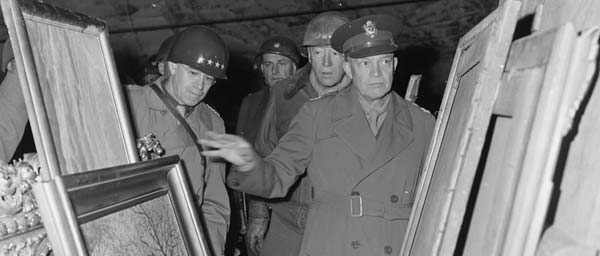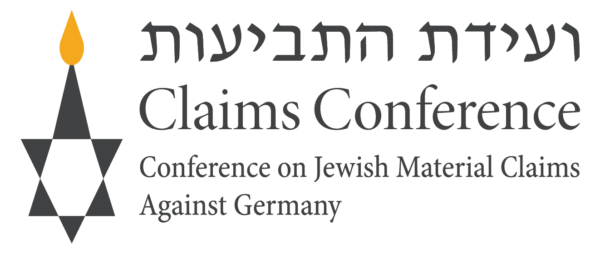Looted Art and Cultural Property
 General Dwight D. Eisenhower inspects art treasures looted by the Germans and stored away in the salt mine at Merkers, Germany. (photo-National Archives)
General Dwight D. Eisenhower inspects art treasures looted by the Germans and stored away in the salt mine at Merkers, Germany. (photo-National Archives)Overview
The Claims Conference and the World Jewish Restitution Organization (WJRO) have begun working with governments and Jewish communities around the world toward the restitution of Jewish-owned art and cultural property that was lost and plundered during the Holocaust. The organizations are focusing on the systemic issues involved in art restitution in order to improve processes by which owners and heirs may recover their property.
The return of plundered artworks and religious artifacts has deep personal meaning, often beyond that of the restitution of other types of assets. These personal possessions were valued for their beauty and cultural and familial significance. In many cases, these artworks or artifacts are the last personal link heirs may have to families destroyed in the Holocaust. Many of these artworks have ended up in museums around the world, with no centralized method for families to locate them. A worldwide effort for the restitution of cultural and religious property will help families to re-acquire treasures that rightfully belong to them.
The difficulty of transporting art across international borders, the difficulty of tracing art transactions through the decades, the lack of public records documenting original ownership, and the lack of a central authority to arbitrate claims for artwork have all contributed to the slow progression of art and cultural property restitution. However, major conferences and resolutions during the past decade have established international principles regarding cultural property restitution:
- Washington Conference Principles on Nazi-Confiscated Art (1998)
- Resolution 1205 of the Parliamentary Assembly of the Council of Europe (1999)
- Declaration of the Vilnius International Forum on Holocaust-Era Looted Cultural Assets (2000)
- The forty-seven countries that participated in the Conference on Holocaust Era Assets held in Prague adopted the Terezin Declaration (2009)
Relevant Issues
The Claims Conference recognizes many legislative and procedural issues regarding looted movable art and cultural property, and is focused on
- Increasing public awareness of the restitution efforts for cultural and religious property looted from Jews;
- Decreasing barriers to identifying movable property looted from Jews. Institutions should disclose their provenance records and those that have not engaged in provenance research should do so to certify that they have no looted items;
- Fostering a hospitable climate for individual claims in all countries, and establishing a practical, non-litigation claims process;
- Convincing governments that hold looted movable assets, such as artworks and religious property, that they have a moral obligation to identify and return the assets to their rightful heirs; and
- Determining that in cases where heirs cannot be identified, the cultural or religious property should be returned to the Jewish people rather than become the property of those governments that currently hold it.
Our Current Policy
In summary, the current cultural property restitution focus of the Claims Conference/WJRO is an emphasis on public institutional provenance research and the creation of a just and simple property restitution program for claimants. The Claims Conference/WJRO should not take on representation of individual claimants. These organizations’ committment to the recovery and restitution of looted Jewish cultural property is a continuation of the commitment to the recovery of other forms of looted Jewish property, such as real estate and insurance claims. The effort to ensure that Judaica is recognized as Jewish property is of the utmost moral importance.

